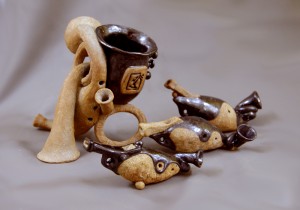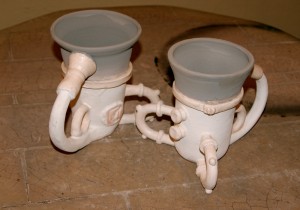 The last batch of glaze tests included a few pinch pot ocarinas and a MugPhlute. The natural look of the reduction fired stoneware with minimal glaze accents seems to work well. The pieces in this image are all high-fired stoneware with red iron oxide brushed into the textured and stamped features. The glaze is St. John’s Black, applied with a brush. The Bailey gas kiln, loaded with these clay instruments as well as student projects from this semester, was fired to cone 10.
The last batch of glaze tests included a few pinch pot ocarinas and a MugPhlute. The natural look of the reduction fired stoneware with minimal glaze accents seems to work well. The pieces in this image are all high-fired stoneware with red iron oxide brushed into the textured and stamped features. The glaze is St. John’s Black, applied with a brush. The Bailey gas kiln, loaded with these clay instruments as well as student projects from this semester, was fired to cone 10.
This semester’s wheel-throwing course pulled me away from making the usual quantity of ceramic musical instruments, but it has also opened new avenues to explore. Having a respectable palette of stamping, texturing, and glazing combinations will make future project planning easier and, hopefully, more predictable.

